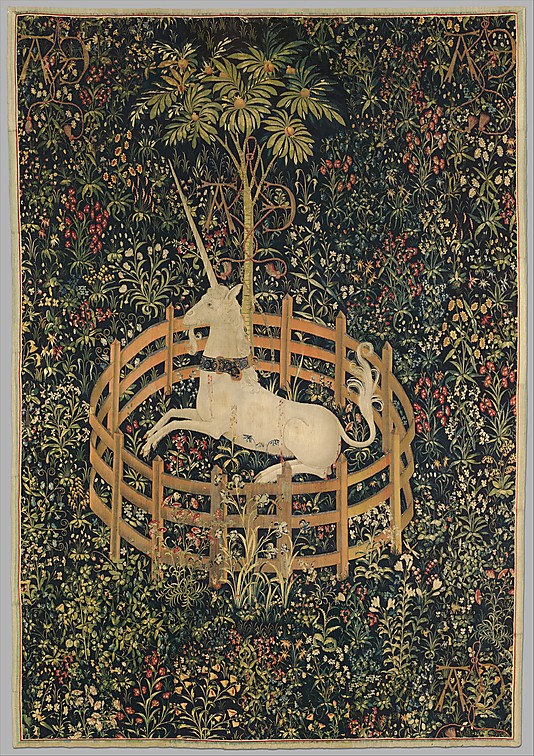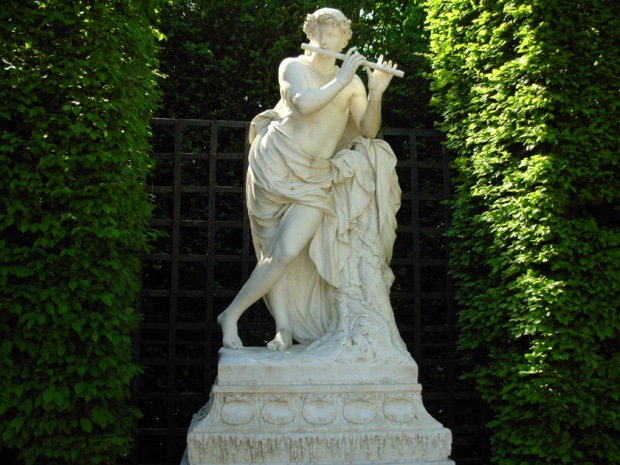Real Gardens that Inspired Art

The monthly ArtSmart Roundtable brings together some of the best art-focused travel blogs to post on a common theme. This month we are discussing Spring! Take a look at all the great stories at the bottom of the page.

Unfortunately the unicorn in this lovely garden is pure fantasy. “The Unicorn in Captivity”, Netherlandish, 1495-1505 (Photo: The Cloisters Collection)
While Washington D.C. has been stubbornly cold this March, I’m just starting to see the first bulbs pop up. And nothing announces Spring like flowers! Gardens and their exquisite flora have always been a popular subject in Art, but not all of the places in these paintings are made up locations. Let’s take a look at a few of the “real” gardens behind some famous paintings.
The Muse of Impressionism

Claude Monet’s “Water Lilies and the Japanese bridge”, 1897–99, Princeton University Art Museum (Photo: Wikimedia)
Mid-career Monet and his young family moved from Paris to the countryside of Normandy and the small town of Giverny. Here he constructed a large garden that would become the inspiration for much of his later works. Here Monet continued to abstract his surroundings focusing on the fleeting shimmers of color and light across the flowering hedges, trees, and pond. You can almost see the breezes subtly sway the drooping willows in the paintings.

Monet’s gardens in Giverny, France today (Photo: shogunangel, flickr)
To study the paintings beside their actual subjects, you have to visit Claude Monet’s Garden at Giverny. Maintained by a non-profit museum, you can see the artist’s studio, the flower gardens, the Japanese Bridge, and most importantly, the water lilies.
The Aristocratic Playground

“The Secret Meeting” (or, “Les Progrès de l’amour – Le rendez-vous”) by Jean-Honoré Fragonard, 1771, now in the Frick Collection, New York City (Photo: Google Art Project)
Time in a garden is for relaxing, quiet and idleness. But no one can turn a frivolous day among flowers and fountains into a naughty tryst like Jean-Honoré Fragonard. Perhaps the most famous painter of the Rococo Period, known for its over the top ornamental decorations and superficialism, Fragonard was the go to painter for portraits of mistresses and subtly erotic images. Some of his most popular scenes include the secret meeting of lovers, coy games, and flirtatious interactions all set in fertile gardens.

A Statue of Acis from the Grove of Domes, Gardens of Versailles (Photo: Wikimedia)
To ponder the garden affairs of 18th century aristocrats, you have to visit the Gardens of Versailles, just outside Paris. At over 800 hectares, that makes for a lot of hidden benches and well isolated groves. This elegant and well maintained green space is an exemplary example of the period and to a lesser extent was repeated in all the luxurious châteaux of the time. These green spaces provided the perfect playground for the wealthy and indiscreet.
The Indoor Country Estate

The Garden Room fresco from The House of the Golden Bracelet, Pompeii, Italy shows small plaques and theatrical masks amid a wild garden. (Photo: Wikimedia)
The villas of wealthy ancient Romans were typically arranged around an interior garden, but the residents weren’t always trying to tame nature with this domestic green space. Inside the House of the Golden Bracelet (Casa del Bracciale d’oro) in Pompeii we find a massive fresco of a wild, bird-filled garden. The “Garden Room” is painted along three walls that opened into the actual garden. It must have acted like a visual extension of the existing courtyard garden.

Detail from Garden Room, The House of the Golden Bracelet, Pompeii, Italy (Photo: Wikimedia)
This must have been one of the most luxurious and relaxing rooms in the villa. Wildflowers seem to grow haphazardly beneath an awning of lush ferns and shrubs. Several species of birds are perched in the greenery or fly above. You can almost hear their songs, or at least the buzz of bees hopping from one flower to the next.

The Umbria Countryside (Photo: Barbara Piancastelli, flickr)
It’s not hard to find the inspiration for this organic garden today in Italy. Wander into the countryside of Tuscany, Campania, or Emilia-Romagna and you’ll find an assortment of wildflowers mixed in with the grasses and shrubs. Here you can enjoy the domestic aspiration of the urban ancient Roman – a quiet, rural estate away from it all!
What other inspirational gardens have you discovered?
 For the rest of the April ArtSmart Roundtable, check out:
For the rest of the April ArtSmart Roundtable, check out:
- Lizzie of WanderArti – Spring Art Fairs in Europe
- Alexandra of ArtTrav – Art Parks in Tuscany
- Pal & Lydian of Art Weekenders – The World’s Best Open Air Museums
- Jenna of This is My Happiness – Primavera…And so what?




Beautiful selection of paintings! I have always wanted to visit Monet’s garden- it looks gorgeous.
LikeLike
Giverny is still on the to-see list, especially keen on doing so after our recent visit to the Orangerie in Paris. But what really caught my attention here is the “Garden Room”. Beautiful fresco, and never heard of it. And yes, heading out to the Italian countryside would be nice now too… So much to plan for 🙂
LikeLike
The olive trees of Saint Rémy de Provence inspired quite a few paintings (Van Gogh) and a wonderful post (yours) 😉
LikeLike
Thank you Covetotop! Glad to hear from you! I was trying to think of Spring garden paintings and didn’t think it was right to include Van Gogh this time. His paintings from Southern France remind me of Summer. Maybe that will be a topic later in the year. 😉
LikeLike
What a beautiful collection and just in time for spring. The art of spring, inspiring the renewal! Great job my friend!!
LikeLike